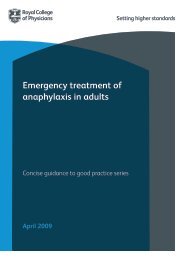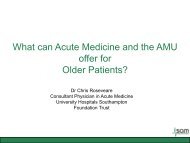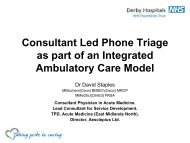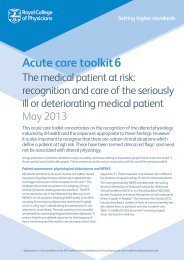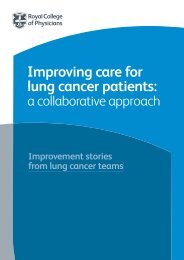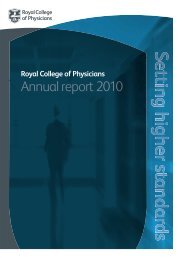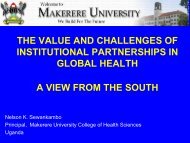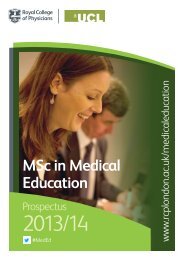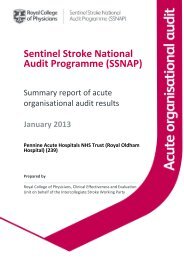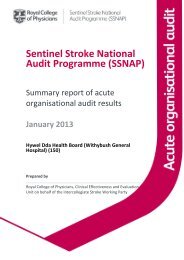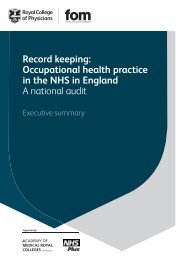Consultant physicians working with patients - Royal College of ...
Consultant physicians working with patients - Royal College of ...
Consultant physicians working with patients - Royal College of ...
Create successful ePaper yourself
Turn your PDF publications into a flip-book with our unique Google optimized e-Paper software.
2 Specialties Cardiovascular medicineCardiovascular medicine and paediatric cardiology<strong>with</strong> adult congenital cardiologyDr Jane Flint BSc MD FRCP <strong>Consultant</strong> cardiologist1 Description <strong>of</strong> the specialtyWhat is the specialty?Cardiovascular medicine involves the management <strong>of</strong><strong>patients</strong> <strong>with</strong> suspected or confirmed cardiovasculardisease and conditions <strong>of</strong> the heart, circulation andlinked organs associated <strong>with</strong> diabetes, renal disease orcerebrovascular disease. Paediatric cardiology is aspecialty that deals <strong>with</strong> all aspects <strong>of</strong> care <strong>of</strong> <strong>patients</strong><strong>with</strong> congenital heart disease, from before birth toadulthood. More and more <strong>patients</strong> have grown-upcongenital heart disease (GUCH) and they are followedin GUCH centres and local centres <strong>with</strong> joint expertise –an example <strong>of</strong> improved integration <strong>of</strong> services (seesection 7). Regionally coordinated genetics andpathology services are being developed forinvestigation <strong>of</strong> people <strong>with</strong> a family history <strong>of</strong> suddendeath. There is no room for complacency if we are toprevent further cases <strong>of</strong> premature cardiac death andimprove quality <strong>of</strong> life for people <strong>with</strong> chronic heartdisease.Who are the <strong>patients</strong>?Most <strong>patients</strong> arrive at emergency departments as acuteadmissions, presenting <strong>with</strong> shortness <strong>of</strong> breath, chestpain or some other cardiac symptom such as transientloss <strong>of</strong> consciousness. They are stratified according torisk so that those <strong>with</strong> acute coronary or anotherhigh-risk syndrome (eg arrhythmia) receive appropriatespecialist care on cardiac care units (CCUs), or oncontinuing care or heart failure wards. By mid 2011,94% <strong>of</strong> <strong>patients</strong> <strong>with</strong> ST-elevation myocardial infarction(STEMI) were taken to network-designated centres inEngland for primary percutaneous coronaryintervention (PPCI). 1 Follow-up <strong>of</strong> many differentcardiac disorders <strong>with</strong> increasing subspecialty focus,eg cardiomyopathy and valve disease, isappropriate. Congenital heart disease affects 8out <strong>of</strong> every 1,000 live births, and this represents amajor clinical challenge for detection andmanagement.Main disease patternsThe current emphasis is on early primary prevention,diagnosis and secondary prevention in a largerpopulation <strong>of</strong> people <strong>with</strong> coronary heart disease whoare living for longer. The increase in <strong>patients</strong> <strong>with</strong>heart failure is being addressed through specialisedsupport in the community, but palliative care for<strong>patients</strong> <strong>with</strong> heart failure and cardiac rehabilitationcompleting all care pathways are priorities inEngland in the cardiovascular disease (CVD)Outcomes Strategy (March 2013). Severe aorticstenosis in frail <strong>patients</strong> can now be managed bytransarterial valve implantation (TAVI). The field <strong>of</strong>paediatric cardiology has also become increasinglysubspecialised, <strong>with</strong> new developments in prenataldetection and interventional and electrophysiologicaltreatments, and the outlook for these <strong>patients</strong> hasbeen greatly improved. Treatments for pulmonaryhypertension, cardiac transplantation, andimplantation <strong>of</strong> left ventricular assist devices (LVADs)are concentrated <strong>with</strong>in supra-regional centres. Thepattern <strong>of</strong> endocarditis is ever-changing, and extravigilance is needed since the National Institute forHealth and Care Excellence (NICE) recommendedremoving routine prophylaxis for most susceptible<strong>patients</strong> in 2008.2 Organisation <strong>of</strong> the service and patterns<strong>of</strong> referralA typical serviceThe aim is to provide a seamless transition for adult andchild <strong>patients</strong> from primary to secondary and then totertiary care, as necessary, and back to localrehabilitation <strong>with</strong>in cardiac networks through the use<strong>of</strong> agreed care pathways. Some advances in serviceprovision pioneered <strong>with</strong>in tertiary care are appropriatefor regular use in secondary care, such as implantationprocedures and follow-up <strong>of</strong> <strong>patients</strong> <strong>with</strong> implantablecardioverter defibrillators (ICDs). A key part <strong>of</strong> theagenda for cardiac networks is equity <strong>of</strong> healthcareC○ <strong>Royal</strong> <strong>College</strong> <strong>of</strong> Physicians 2013 47



